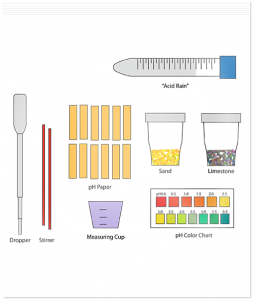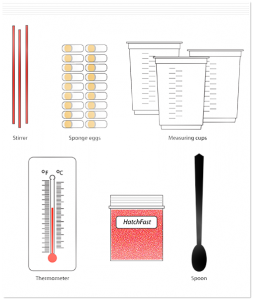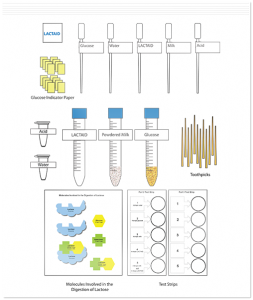Inquiry-based learning starts by posing questions, problems or scenarios for students to investigate. Science Take-Out kits use structured inquiry or guided inquiry, and are a natural lead-in to open-ended inquiry.
As Alan Colburn describes in his article “An Inquiry Primer,” in structured inquiry students are provided with a problem or question to investigate, as well as the procedures and materials for the investigation. Students then collect and analyze data in order to discover the expected outcomes. Structured inquiry teaches students the basics of experimental design, which they can then use when they engage in guided or open inquiry.
Acid Rain and Buffers (STO-107) is an example of a Science Take-Out kit that uses structured inquiry. Students are asked to investigate why acid rain decreases the pH of some lakes and not others. Students create mini-models of lakes with different lake bottom materials—sand and limestone. They add simulated “acid rain” (vinegar) to the lakes to determine which lake bottom material acts as a buffer to keep the pH of the simulated lake water relatively constant. Students collect data and organize it into a table and a graph. They then use evidence from their table and graph to determine which type of lake bottom material acts as a buffer.
In guided inquiry, students are provided with the materials and the problem or question to investigate. Students are then asked to develop their own procedure to solve the problem/question. They determine how to collect and analyze their data to come to a conclusion. Guided inquiry can involve students in developing and testing a hypothesis by designing a simple controlled experiment that includes control and experimental groups.
Science Take-Out offers several kits that lead students from structured inquiry to guided inquiry. In the Experimenting: Factors that Affect Sponge Egg Hatching kit (STO-124), students first conduct a controlled experiment to determine the effect of temperature on the hatching of sponge eggs (gel capsules that dissolve in water to release small sponge “animals”). They then design and conduct their own experiment to test the claim that using a substance called HatchFast speeds up sponge egg hatching. Students are asked to organize their results using appropriate data tables and graphs. They then draw conclusions related to their hypothesis and the experimental results. They also identify potential sources of errors and describe ways that they might improve their experimental design.
The Enzymes and Lactose Intolerance kit (STO-119) also leads students from structured inquiry to guided inquiry as they investigate the action of the enzyme lactase. Students first engage in a guided inquiry activity to determine whether LACTAID, an enzyme supplement, digests lactose. They then design and conduct their own experiment to determine if acid interferes with the action of the enzymes in LACTAID.
Colburn, A. (2000). An inquiry primer. Science Scope, 23(6), 42–44.


